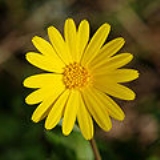
Calendula arvensis
Encyclopedia
Calendula arvensis is a species of flowering plant in the daisy family
known by the common name field marigold. It is native to central and southern Europe, and it is known across the globe as an introduced species
. It is an annual herb not generally exceeding 15 centimeters in height. The leaves are lance-shaped and borne on petioles
from the slender, hairy stem. The inflorescence
is a single flower head
up to 4 centimeters wide with bright yellow to yellow-orange ray florets around a center of yellow disc florets. The fruit is an achene
which can take any of three shapes, including ring-shaped, that facilitate different methods of dispersal
.
Asteraceae
The Asteraceae or Compositae , is an exceedingly large and widespread family of vascular plants. The group has more than 22,750 currently accepted species, spread across 1620 genera and 12 subfamilies...
known by the common name field marigold. It is native to central and southern Europe, and it is known across the globe as an introduced species
Introduced species
An introduced species — or neozoon, alien, exotic, non-indigenous, or non-native species, or simply an introduction, is a species living outside its indigenous or native distributional range, and has arrived in an ecosystem or plant community by human activity, either deliberate or accidental...
. It is an annual herb not generally exceeding 15 centimeters in height. The leaves are lance-shaped and borne on petioles
Petiole (botany)
In botany, the petiole is the stalk attaching the leaf blade to the stem. The petiole usually has the same internal structure as the stem. Outgrowths appearing on each side of the petiole are called stipules. Leaves lacking a petiole are called sessile, or clasping when they partly surround the...
from the slender, hairy stem. The inflorescence
Inflorescence
An inflorescence is a group or cluster of flowers arranged on a stem that is composed of a main branch or a complicated arrangement of branches. Strictly, it is the part of the shoot of seed plants where flowers are formed and which is accordingly modified...
is a single flower head
Head (botany)
The capitulum is considered the most derived form of inflorescence. Flower heads found outside Asteraceae show lesser degrees of specialization....
up to 4 centimeters wide with bright yellow to yellow-orange ray florets around a center of yellow disc florets. The fruit is an achene
Achene
An achene is a type of simple dry fruit produced by many species of flowering plants. Achenes are monocarpellate and indehiscent...
which can take any of three shapes, including ring-shaped, that facilitate different methods of dispersal
Biological dispersal
Biological dispersal refers to species movement away from an existing population or away from the parent organism. Through simply moving from one habitat patch to another, the dispersal of an individual has consequences not only for individual fitness, but also for population dynamics, population...
.

